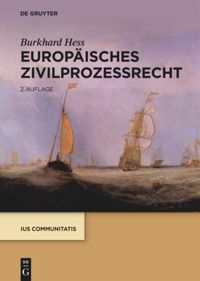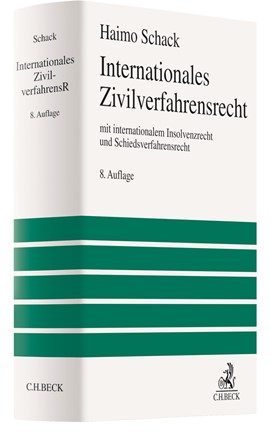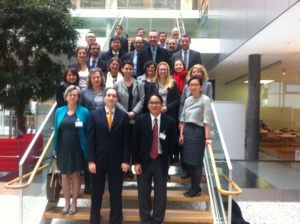One Year of Pandemic-Driven Video Hearings at the German Federal Court of Justice in International Patent Matters: Interview with Federal Judge Hartmut Rensen, Member of the Tenth Panel in Civil Matters
Benedikt Windau, the editor of a fabulous German blog on civil procedural law, www.zpoblog.de, recently interviewed Federal Judge Dr Hartmut Rensen, Member of the Tenth Panel of the division for civil and commercial matters at the German Federal Court of Justice (Bundesgerichtshof) on the experiences with video hearings in national an international patent matters in the pandemic. I allow myself to pick up a few elements from this fascinating interview in the following for our international audience:
The Tenth Panel functions as a court of first appeal (Berufungsgericht) in patent nullity proceedings and as a court of second appeal for legal review only (Revisionsgericht) in patent infringement proceedings. In both functions, particularly in its function as court of first appeal, actors from all over the world may be involved, and indeed, Judge Rensen reported about parties and their respective representatives and teams from the USA, Japan, South Korea, the UK, France, Italy and Spain during the last year.
Obviously, the start of the pandemic raised the question how to proceed, once physical hearings on site could no longer take place as before, since particularly in the appeal proceedings parties had usually appeared with several lawyers, patent lawyers, technical experts, interpreters etc., i.e. a large number of people had gathered in rather small court rooms, to say nothing of the general public and media. Staying all proceedings until an expected end of the pandemic (for which we are still waiting) would indeed have infringed the parties‘ fundamental procedural right to effective justice, abstaining from oral hearings and resorting to submission and exchange of written documents instead, as theoretically provided as an option under section 128 (2) German Code of Civil Procedure, would evidently not have been satisfying in matters as complex as patent matters (as well as probably in most other matters).
German civil procedural law allows for video hearings under section 128a (1) German Code of Civil Procedure. It reads (in the Governments official, yet may be not entirely perfect translation): „The court may permit the parties, their attorneys-in-fact, and advisers, upon their filing a corresponding application or ex officio, to stay at another location in the course of a hearing for oral argument, and to take actions in the proceedings from there. In this event, the images and sound of the hearing shall be broadcast in real time to this location and to the courtroom.“ The key word is „permit“. If the court „permits“ the parties etc. to proceed as described, it does not mean that the parties are required to do so. And indeed, parties applied for postponing scheduled hearings instead of going into video hearings. The presiding judge of the court has to decide on such a motion according to section 227 on „changes of date for scheduled hearings“. Section 227 (1) Sentence 1 reads: „Should substantial grounds so require, a hearing may be cancelled or deferred, or a hearing for oral argument may be postponed“. Sentence 2 reads: „The following are not substantial grounds: No. 1: The failure of a party to appear, or its announcement that it will not appear, unless the court is of the opinion that the party was prevented from appearing through no fault of its own“. Is this enough ground to reject the motion in light of the offer to go into video hearings? The Tenth Panel was brave enough to answer this question positively. Further, it was brave enough to overcome the friction between section 128a – permission for video hearings to be decided by the entire bench of the court at the opening of the first hearing – and section 227 (1) – decision about the motion to postpone a scheduled hearing by the presiding judge prior to that hearing. In the interest of progress in e-justice and effective access to justice in times of the pandemic, this is to be applauded firmly, all the more because the Panel worked hard, partly on its own initiative (as the general administration of the court would have been far too slow), to equip the court room with the necessary video technology: several cameras showing each judge and the entire bench, at the same time making sure that no camera reveals internal notes, the same for each party and team. The video conference tool that is currently used is MS Teams (despite all obvious concerns) as being the most reliable one in terms of broadcasting image and sound. The Panel invited to technical rehearsals the day before the hearing and for feed-backs afterwards, in order to improve itself and in order to build up trust, which seemed to have been quite successful. The specific nature of patent proceedings resulted in the insight that the function „screen sharing“ is one of the most helpful tools which will probably continue to be used in post-pandemic times. Sounds to me like examples of best practice. In sometimes rather „traditional“ environments of the German administration of justice, this is not a matter of course.
In relation to sovereignty issues when foreign parties are involved, the Panel takes the view that the territorial sovereignty of a foreign jurisdiction is not affected by a mere permission in the sence of section 128a because the place of the hearings can be considered still as being the locus of the court, i.e. Karlsruhe, Germany. Judge Rensen reported about talks between the Federal Ministry of Justice and its counterparts on the level of the states to the opposite, but as Judge Rensen pointed out, these are ongoing talks amongst ministerial officers, no court decisions or specific legislations that would bind the Panel. Things are certainly more difficult when it comes to the taking of evidence. The Panel has done this only once so far, apparently within the scope of application of the EU Taking of Evidence Regulation. This case was specific, insofar as the testimony appeared to be entirely in line with and supported by undisputed facts and other testimonies, and these circumstances established a particularly solid overall picture about the point. This is why the Panel held the video testimony to be sufficient, which might mean that in mixed pictures the Panel might tend towards insisting on testimony in physical presence. In general, Judge Rensen supported judge-made progress, as opposed to specific legislation on legal assistance, as such legislation (like the EU legislation, including its latest recast on the matter) might lead to the misconception that such legislation would be required as a matter of principle in all cases to allow video hearings with foreign participants. For this reason, he pleaded for taking this factor into account before reforming section 128a (if at all), as such legislation would not be in sight in relation to a number of third states. At the same time the work of e.g. the HCCH on improving and modernising legal assistance under the HCCH 1970 Convention on the Taking of Evidence may be helpful nevertheless to promote and support video hearings in legal certainty, see e.g. the HCCH 2020 Guide to good practice on the use of video-link under the Hague Evidence Convention, but indeed the approach towards states staying outside these legal frameworks must be considered likewise.


 International Law” has finished its work with the adoption and publication of the “Kyoto Guidelines on Intellectual Property and Private International Law”. The Guidelines are the outcome of an international cooperation of a group of 36 scholars from 19 jurisdictions lasting for ten years under the auspices of ILA. The Kyoto Guidelines have been approved by the plenary of the ILA 79th Biennial Conference, held (online) in Kyoto on December 13, 2020. The Guidelines provide soft-law principles on the private international law aspects of intellectual property, which may guide the interpretation and reform of national legislation and international instruments, and may be useful as source of inspiration for courts, arbitrators and further research in the field. Different from older regional projects, the Kyoto Guidelines have been prepared by experts from different world regions. The Guidelines have now been published with extended comments as a special issue of the Open Access journal JIPITEC:
International Law” has finished its work with the adoption and publication of the “Kyoto Guidelines on Intellectual Property and Private International Law”. The Guidelines are the outcome of an international cooperation of a group of 36 scholars from 19 jurisdictions lasting for ten years under the auspices of ILA. The Kyoto Guidelines have been approved by the plenary of the ILA 79th Biennial Conference, held (online) in Kyoto on December 13, 2020. The Guidelines provide soft-law principles on the private international law aspects of intellectual property, which may guide the interpretation and reform of national legislation and international instruments, and may be useful as source of inspiration for courts, arbitrators and further research in the field. Different from older regional projects, the Kyoto Guidelines have been prepared by experts from different world regions. The Guidelines have now been published with extended comments as a special issue of the Open Access journal JIPITEC: